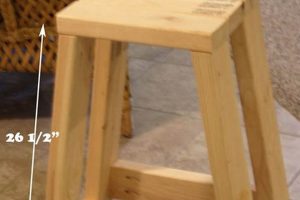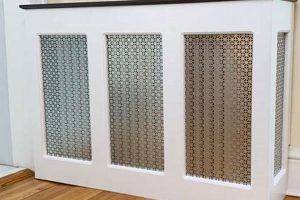A homemade solution crafted for the purpose of removing marker residue and ghosting from erasable writing surfaces is a common need. These surfaces, prevalent in educational and professional environments, require routine maintenance to ensure legibility and longevity. Such solutions often utilize readily available household ingredients, presenting an alternative to commercially produced cleaning agents.
The practice of formulating one’s own cleaning mixtures for these boards offers several advantages. Economic savings are a primary motivator, as the component ingredients are typically less expensive than specialized retail products. Furthermore, creating a customized formula allows for control over the chemical composition, potentially reducing exposure to harsh chemicals and mitigating environmental impact. This approach aligns with principles of resourcefulness and responsible consumption.
The subsequent discussion will address effective formulations, application techniques, and preventative measures to maintain the optimal condition of erasable writing boards, thereby extending their lifespan and preserving their functionality within various settings. This will include exploring the use of common household items and their specific properties in achieving a clean surface.
Tips for Effective DIY Dry Erase Board Maintenance
Maintaining a dry erase board’s cleanliness and functionality requires proper techniques and preventative measures. The following tips outline methods to ensure optimal performance and longevity, focusing on practical application and readily available resources.
Tip 1: Isopropyl Alcohol Application: Utilize a solution of 70% isopropyl alcohol applied with a microfiber cloth. This solvent effectively dissolves marker residue without damaging the board’s surface. Ensure adequate ventilation during application.
Tip 2: Vinegar and Water Mixture: A mixture of equal parts white vinegar and water provides a gentle yet effective cleaning solution. Apply with a soft cloth and wipe dry to prevent streaking. This method is particularly useful for regular maintenance.
Tip 3: Baking Soda Paste: For persistent stains or “ghosting,” create a paste of baking soda and water. Gently rub the paste onto the affected area, then wipe clean with a damp cloth. This acts as a mild abrasive to remove stubborn marks.
Tip 4: Proper Marker Usage: Employ only dry erase markers specifically designed for use on erasable boards. Permanent markers or other types of pens will permanently damage the surface, rendering it unusable.
Tip 5: Regular Cleaning Schedule: Establish a consistent cleaning schedule based on the frequency of use. Daily cleaning prevents the build-up of marker residue, making removal easier and minimizing the need for more aggressive cleaning methods.
Tip 6: Microfiber Cloths are Essential: Opt for microfiber cloths over paper towels or other materials. Microfiber cloths are non-abrasive and effectively lift away marker residue without scratching the board’s surface.
Tip 7: Preventative Measures: Avoid leaving marker writing on the board for extended periods. The longer the writing remains, the more difficult it becomes to remove, increasing the likelihood of ghosting. Erase promptly after each use.
Adhering to these maintenance strategies ensures the sustained clarity and usability of dry erase boards, minimizing the need for frequent replacement and contributing to a more cost-effective resource management approach.
The following sections will delve into advanced stain removal techniques and troubleshooting common issues encountered with dry erase board maintenance.
1. Ingredient Efficacy
The effectiveness of any homemade dry erase board cleaning agent is fundamentally determined by the inherent properties of its constituent ingredients. A clear cause-and-effect relationship exists: the appropriate selection and concentration of ingredients directly influence the solution’s capacity to dissolve and remove marker residue without causing damage to the board’s surface. Ingredient efficacy, therefore, constitutes a critical component in the successful formulation of a do-it-yourself cleaning solution.
Examples of this connection are readily apparent. Isopropyl alcohol, a common ingredient, functions as a solvent, breaking down the non-polar bonds present in many dry erase marker inks. Its efficacy is concentration-dependent; a solution with a low alcohol content may prove ineffective in removing stubborn marks. Similarly, the acidity of vinegar allows it to dissolve mineral deposits and light residue, but its efficacy is maximized when diluted to prevent potential damage to certain board surfaces. Understanding the specific chemical interactions between ingredients and marker compounds, as well as board materials, is paramount.
In conclusion, the practical significance of ingredient efficacy cannot be overstated. An informed approach to ingredient selection, based on chemical properties and their known effects on dry erase board surfaces, is essential for achieving optimal cleaning results. By carefully considering ingredient efficacy, it minimizes the risk of board damage while maximizing cleaning performance, and prolongs the usability of the dry erase surface.
2. Surface Compatibility
Surface compatibility represents a critical factor in the successful application of homemade dry erase board cleaning solutions. Different board surfaces exhibit varying levels of resistance to chemical interactions, necessitating careful consideration of cleaning agent composition to prevent damage or degradation.
- Material Composition Impact
The type of material from which a dry erase board is constructed directly influences its susceptibility to cleaning solutions. Melamine boards, for instance, possess a relatively porous surface, making them more prone to staining and damage from harsh chemicals. Conversely, porcelain-on-steel boards exhibit greater resistance due to their non-porous and durable nature. The selection of cleaning agents must align with the board’s material composition to mitigate potential harm.
- pH Sensitivity
The pH level of a homemade cleaning solution can significantly affect the board’s surface. Highly acidic or alkaline solutions can etch or discolor certain materials, leading to permanent damage. A neutral pH is generally recommended to ensure compatibility across a range of board types. For example, concentrated vinegar, while effective as a cleaner, may prove too acidic for regular use on sensitive surfaces, necessitating dilution.
- Solvent Interactions
Various solvents commonly found in household cleaners can interact negatively with the coating on dry erase boards. Strong solvents may dissolve or weaken the coating, resu
lting in a loss of erasability. Isopropyl alcohol, while generally considered safe in diluted form, should be used cautiously and tested in an inconspicuous area first to ensure compatibility. Other solvents, such as acetone, should be avoided due to their aggressive dissolving properties. - Long-Term Effects of Incompatibility
Repeated use of incompatible cleaning solutions can lead to gradual degradation of the board’s surface, manifesting as reduced erasability, discoloration, or even structural damage. These long-term effects can significantly shorten the lifespan of the board, increasing the need for replacement. Implementing preventative measures, such as testing solutions in small areas and adhering to recommended cleaning practices, is essential for preserving surface integrity.
The insights gained from understanding surface compatibility emphasize the importance of informed decision-making when formulating homemade dry erase board cleaners. By carefully considering the board’s material, the pH of the cleaning agent, potential solvent interactions, and the long-term consequences of incompatibility, individuals can ensure effective cleaning without compromising the integrity and functionality of the dry erase surface.
3. Application Technique
The method by which a homemade dry erase board cleaner is applied directly influences its effectiveness and the long-term preservation of the board’s surface. Incorrect application can negate the benefits of a well-formulated cleaning solution, potentially causing damage or failing to adequately remove marker residue. A direct cause-and-effect relationship exists between technique and outcome; proper execution maximizes cleaning efficacy while minimizing the risk of adverse effects. The application technique is not merely a supplemental step but an integral component of a complete cleaning process.
Consider, for example, the common practice of using a spray bottle to apply a cleaner. While seemingly efficient, direct spraying can lead to uneven distribution and oversaturation, potentially causing streaks or damaging sensitive board surfaces. A more controlled approach involves dampening a microfiber cloth with the cleaner and gently wiping the board in a circular motion. This technique ensures uniform coverage and minimizes the risk of excessive moisture exposure. Similarly, the type of cloth used is crucial. Abrasive materials, such as paper towels, can scratch the surface, while microfiber cloths lift away residue without causing damage. The pressure applied is also a factor; excessive force can embed marker particles deeper into the board’s pores, hindering removal and potentially damaging the surface coating.
In conclusion, the application technique is paramount to the successful use of any homemade dry erase board cleaner. A thorough understanding of appropriate methods, including controlled application, the use of non-abrasive materials, and appropriate pressure, is essential for achieving optimal cleaning results and preserving the integrity of the board’s surface. Neglecting this aspect can undermine the benefits of a well-formulated cleaner, leading to ineffective cleaning or, worse, irreversible damage. The attention to detail in application technique is as important as the quality of the cleaner itself.
4. Residue Removal
Effective residue removal is a central objective when utilizing homemade dry erase board cleaning solutions. The persistent presence of marker remnants, commonly referred to as “ghosting,” diminishes board legibility and aesthetic appeal, potentially impacting its functional value. Addressing this issue effectively requires a nuanced understanding of the factors influencing residue adhesion and the techniques for its mitigation.
- Solvent Selection and Residue Dissolution
The choice of solvent within the cleaning solution directly influences its ability to dissolve and lift marker residue from the board’s surface. Isopropyl alcohol, a common component, exhibits a moderate solvency for many dry erase marker inks. However, the efficacy varies depending on the ink’s specific chemical composition and the length of time the ink has been adhered to the surface. Inadequate solvent selection results in incomplete dissolution, leaving behind visible residue. The concentration of the solvent is also critical; excessively diluted solutions lack the necessary strength, while overly concentrated solutions may damage certain board surfaces.
- Mechanical Action and Residue Loosening
Mechanical action, typically provided by wiping with a cloth, complements the solvent’s dissolving action by physically loosening the residue from the board. The type of material used for wiping significantly impacts this process. Microfiber cloths, due to their fine texture and absorbent properties, effectively lift residue without scratching the surface. Abrasive materials, conversely, can damage the board and embed residue further into the surface pores. Proper technique involves consistent, overlapping strokes with moderate pressure to ensure uniform residue removal.
- Surface Porosity and Residue Penetration
The porosity of the dry erase board’s surface influences the degree to which marker residue penetrates and adheres. More porous surfaces allow residue to seep into microscopic crevices, making removal more challenging. Solutions containing mild surfactants can aid in penetrating these pores and loosening embedded residue. Regular cleaning minimizes the opportunity for residue to accumulate and penetrate deeply. Boards with non-porous surfaces generally exhibit superior cleanability and reduced residue retention.
- Residue Reactivity and Chemical Transformation
Over time, marker residue can undergo chemical transformations due to exposure to air, light, and humidity. These transformations can alter the residue’s chemical composition, making it more resistant to conventional cleaning methods. In such cases, more aggressive cleaning agents or specialized residue removers may be required. However, the use of such agents must be approached with caution to avoid damaging the board’s surface. Preventative measures, such as regular cleaning and the use of markers with easily removable inks, can minimize the occurrence of these chemical transformations.
The multifaceted nature of residue removal underscores the importance of a comprehensive approach to dry erase board maintenance. Effective cleaning solutions combine appropriate solvent selection, mechanical action, surface considerations, and an understanding of residue reactivity to ensure thorough removal and the long-term preservation of board functionality.
5. Long-Term Preservation
The longevity and continued usability of dry erase boards are directly influenced by the maintenance practices employed. The selection and application of homemade cleaning solutions play a crucial role in extending the lifespan of these surfaces, preventing degradation, and ensuring consistent performance over time. Long-term preservation, therefore, is inextricably linked to the properties and application of self-formulated cleaning agents.
- Surface Integrity and Cleaning Agent Formulation
The chemical composition of a homemade cleaner must be carefully considered to avoid damaging the board’s writing surface. Aggressive solvents or abrasive ingredients can gradually erode the coating, reducing erasability and creating a textured surface prone to staining. Gentle, pH-balanced solutions are essential for maintaining surface integrity over extended periods. For instance, utilizing a diluted vinegar solution rather than undiluted bleach helps prevent surface etching and discoloration, preserving the board’s smoothness and reflectivity.
- Preventing Ghosting and Residue Buildup
The accumulation of marker residue, known as “ghosting,” can progressively obscure the writing surface and diminish its clarity. Regular cleaning with appropriate solutions is essential for preventing this buildup. Solutions that effectively dissolve marker pigments without leaving a film or residue are crucial. For example, a solution of isopropyl alcohol and water, when properly applied, can lift away marker particles, preventing them from settling into the board’s porous surface and causing long-term ghosting.
- Material Degradation and Environmental Factors
Environmental factors, such as UV exposure and humidity, can contribute to the degradation of dry erase board materials. Certain homemade cleaners can exacerbate these effects if they contain reactive compounds. Solutions that offer a protective barrier against UV radiation or help regulate moisture levels can prolong the board’s lifespan. For example, adding a small amount of carnauba wax to a cleaning solution can provide a thin, protective layer against environmental stressors, reducing the rate of material degradation.
- Optimizing Cleaning Frequency and Technique
The frequency and technique of cleaning directly influence the long-term condition of the dry erase board. Infrequent cleaning allows marker residue to harden and become more difficult to remove, requiring more aggressive cleaning methods that can damage the surface. Regular cleaning with gentle solutions and appropriate wiping techniques, such as using microfiber cloths, minimizes the need for harsh chemicals and abrasive scrubbing, extending the board’s usability. For example, establishing a daily or weekly cleaning schedule based on usage intensity can significantly reduce the likelihood of long-term staining and surface deterioration.
In summary, the long-term preservation of dry erase boards hinges on the judicious selection and application of homemade cleaning solutions. By prioritizing surface integrity, preventing ghosting, mitigating environmental factors, and optimizing cleaning practices, users can significantly extend the lifespan and maintain the performance of these valuable communication tools. A proactive and informed approach to maintenance is essential for maximizing the return on investment and ensuring the continued functionality of dry erase boards in various settings.
Frequently Asked Questions
This section addresses common inquiries regarding homemade solutions for cleaning dry erase boards. The information presented aims to provide clarity on best practices and potential pitfalls.
Question 1: Are all household cleaning products safe for use on dry erase boards?
No. Many commercially available cleaning products contain harsh chemicals that can damage the writing surface, leading to reduced erasability or permanent staining. It is essential to select cleaning agents specifically formulated for use on dry erase boards or to utilize proven homemade alternatives with caution.
Question 2: What are the risks associated with using abrasive materials to clean a dry erase board?
Abrasive materials, such as scouring pads or coarse cloths, can scratch the surface of a dry erase board. These scratches create microscopic grooves that trap marker particles, making the board difficult to clean and contributing to “ghosting.” Microfiber cloths are recommended for their non-abrasive cleaning properties.
Question 3: How frequently should a dry erase board be cleaned?
The cleaning frequency depends on the level of usage. Boards used daily should be cleaned daily. Boards used less frequently can be cleaned less often, but regular maintenance prevents the build-up of stubborn marker residue and staining.
Question 4: Is it possible to completely remove “ghosting” from a dry erase board?
Complete removal of ghosting is not always possible, particularly if the board has been subjected to prolonged use or improper cleaning methods. However, various homemade solutions and techniques, such as using a baking soda paste, can significantly reduce the appearance of ghosting.
Question 5: Can permanent markers be removed from a dry erase board using homemade cleaning solutions?
While not guaranteed, attempting to remove permanent marker with a dry erase marker and then wiping the board may work. Following up with isopropyl alcohol or a specialized cleaner may also help, but there is a risk of permanent staining depending on the board’s surface.
Question 6: Are there any preventative measures to reduce the need for aggressive cleaning of dry erase boards?
Yes. Erasing marker markings promptly after use, using high-quality dry erase markers, and avoiding prolonged exposure to direct sunlight can all help to minimize the build-up of stubborn residue and reduce the need for harsh cleaning methods.
In conclusion, a proactive approach to dry erase board maintenance, characterized by regular cleaning with appropriate solutions and preventative measures, is essential for preserving the integrity and functionality of these surfaces.
The following section will explore advanced troubleshooting techniques for resolving persistent dry erase board cleaning challenges.
Conclusion
The preceding exploration has illuminated the multifaceted considerations surrounding the creation and utilization of homemade solutions for maintaining dry erase boards. The efficacy of these “diy dry erase board cleaner” options hinges upon a delicate balance of ingredient selection, surface compatibility, application technique, and a thorough understanding of residue removal principles. Furthermore, a commitment to preventative maintenance significantly contributes to the long-term preservation of these surfaces.
Effective implementation of these strategies ensures the continued functionality and aesthetic appeal of dry erase boards across diverse environments. Continued research and refinement of homemade cleaning solutions represent a prudent approach to resource management and responsible consumption. The diligent application of knowledge regarding “diy dry erase board cleaner” practices ultimately contributes to the sustained utility of this ubiquitous communication tool.







